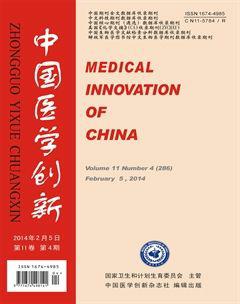狼疮性肾炎患者并发院内感染病原菌分布及其危险因素分析
冯要菊
【摘要】 目的:探讨狼疮性肾炎患者并发院内感染病原菌分布及其危险因素分析,以致获取更好的治疗手段。方法:选取本院2009年5月-2012年5月收治的80例狼疮性肾炎患者进行研究,观察患者院内感染病原菌分布,以及其感染的危险因素。结果:80例患者有30例患者发生院内感染,发生率为37.5%。其中真菌感染12例,占感染患者的40.0%。经危险因素分析发现,相对单纯激素治疗,联合治疗发生院内真菌感染的发生率显著增高,比较差异有统计学意义(P<0.05)。结论:狼疮性肾炎患者易并发院内真菌感染,减少住院时间,营养状况的改善,以及适当的治疗方案有助于降低住院患者真菌感染的发生。
【关键词】 狼疮性肾炎; 真菌感染; 危险因素
系统性红斑狼疮(SLE)是临床上常见的特异性自身免疫性疾病,而狼疮性肾炎(LN)是SLE最常见及最重要的内脏并发症[1-2]。由于患者自身疾病的特点及治疗的需要,LN患者院内感染发病率较高,病变常导致血管内皮损伤、纤维素样变性、非炎症性坏死以及微血栓的形成,以致发展为肾功能衰竭,后者是导致LN患者死亡的主要原因[3-4]。国内文献报道,在LN并发的院内感染中,真菌感染较为常见[5]。本研究就本院2009年5月-2012年5月收治的80例狼疮性肾炎进行院内感染病原菌及其危险因素的分析,取得了较好的效果,现将结果报告如下。
1 资料与方法
1.1 一般资料 选取本院2009年5月-2012年5月收治的80例狼疮性肾炎患者进行研究。入组条件:(1)患者均满足1997年美国风湿病学会修订的LN诊断标准,并发肾脏损害表现,如持续性蛋白尿(>0.5 g/d,或者>+++)管型尿)(可为红细胞,血红蛋白,颗粒或管状);(2)患者经肾穿刺活检及其实验室相关检查确诊为狼疮性肾炎;(3)患者能够与医务人员进行有效的交流和沟通;(4)患者均符合卫生部制定的《医院感染诊断标准》。排除标准:(1)患者有智力、听力、言语交流沟通障碍,影响患者与医务人员进行交流和沟通;(2)患者入院时已经存在感染;(3)患者合并精神分裂症、双相障碍、偏执性精神障碍等重型精神疾病,无完全民事行为能力;(4)患者不愿意参加本次研究。其中男14例,女66例,年龄16~63岁,平均(32.8±4.2)岁,住院时间为7~54 d,平均(23.4±5.6)d。
1.2 治疗方法 所有患者根据具体情况采用以下治疗方案中的1种。方案1:单纯激素(P)治疗;方案2:激素+霉酚酸酯(P+MMF);方案3:激素+免疫抑制剂环磷酰胺(P+CTX)治疗;方案4:激素冲击疗法+环磷酰胺(P冲击疗法+CTX)治疗。
根据患者细菌学培养,制定治疗方案:院内真菌感染患者均予抗真菌治疗,有病毒感染的,如带状疱疹者,予以抗病毒及对症治疗,合并细菌感染者根据药敏结果或经验予抗生素抗感染治疗。
1.3 统计学处理 采用SPSS 17.0软件对所得数据进行统计分析,计量资料用(x±s)表示,比较采用t检验,计数资料采用 字2检验,以P<0.05为差异有统计学意义。
2 结果
2.1 患者感染情况及病原菌分布情况 80例患者中30例患者发生院内感染,发生率为37.5%。其中真菌感染12例,占感染患者的40.0%。由此可见,导致狼疮性肾炎患者院内感染的主要为真菌感染。真菌感染部位,口腔6例、肺部3例、肠道3例。经患者痰、咽拭子、大便等分泌物中查见真菌菌丝和孢子,其中10例分离出白色念珠菌、2例分离出丝状真菌。剩下病毒感染6例以及细菌感染14例。且交叉感染占18例。
2.2 感染因素分析 患者住院后的感染与住院的时间,治疗的方案,以及患者血清白蛋白及血红蛋白等有显著的相关性,差异均有统计学意义(P<0.05)。与患者的年龄、性别等无显著相关性,差异均无统计学意义(P>0.05)。见表1。
3 讨论
狼疮性肾炎是系统性红斑狼疮累及肾脏所引起的一种免疫复合物性肾炎,是SLE主要的合并症和主要的死亡原因。SLE是一种临床表现为有多系统损害症状的慢性系统性自身免疫疾病,其血清具有以抗核抗体为主的大量不同的自身抗体。其临床特点是病情缓解和急性发作交替为特点,有内脏(肾、中枢神经)损害者预后较差[6-7]。流行病学显示,在我国的患病率为1/1000,高于西方国家报道的1/2000,以女性多见,尤其是20~40岁的育龄女性[8]。
LN并发院内感染的发生率在38.9%~48.6%,真菌感染发生率为12.0%~22.9%[9]。本资料研究结果显示,80例患者有30例患者发生院内感染,发生率为37.5%。其中真菌感染占12例,占感染患者的40.0%。由此可见,导致狼疮性肾炎患者院内感染的主要为真菌感染。真菌感染部位,口腔6例、肺部3例、肠道3例。病毒感染6例以及细菌感染14例。且交叉感染占18例。
经相关性分析得知,患者住院后的感染与住院的时间,治疗的方案,以及患者血清白蛋白及血红蛋白等有显著的相关性,差异均有统计学意义(P<0.05)。与患者的年龄、性别等无显著相关性,差异均无统计学意义(P>0.05)。且血清白蛋白及血红蛋白越高,其感染可能性越小,这说明血清白蛋白和血红蛋白具有保护作用。
对于使用符合治疗方案的患者其感染因素显著增高,可能是因为免疫抑制药物治疗后,患者的免疫功能下降,为真菌等其他的病原菌的感染创造条件。住院时间长,患者接触真菌等病原微生物机会越多,其感染危险因素显著增加。与目前的文献报道类似[10-11]。
综上所述,狼疮性肾炎患者易并发院内真菌感染,减少住院时间,营养状况的改善,以及适当的治疗方案有助于降低住院患者真菌感染的发生。
参考文献
[1] Rojas M A, Lozano J M, Rojas M X, et al. Prophylactic probiotics to prevent death and nosocomial infection in preterm infants[J]. Pediatrics, 2012, 130(5):e1113-1120.
[2] Rosenthal V D, Bijie H, Maki D G, et al. International nosocomial infection control consortium (INICC) report, data summary of 36 countries, for 2004-2009[J]. Am J Infect Control, 2012, 40(5):396-407.
[3] Rosenthal V D, Maki D G, Jamulitrat S, et al. international nosocomial infection control consortium (INICC) report, data summary for 2003-2008, issued June 2009[J].Am J Infect Control, 2010, 38(2):95-104.e2.
[4] Rosenthal V D, Rodrigues C, ?lvarez-Moreno C, et al. Effectiveness of a multidimensional approach for prevention of ventilator-associated pneumonia in adult intensive care units from 14 developing countries of four continents: findings of the International Nosocomial Infection Control Consortium[J].Crit Care Med, 2012, 40(12):3121-3128.
[5]刘旭, 黄慧. 狼疮性肾炎并发医院感染的临床研究[J]. 中华医院感染学杂志, 2010, 20 (6): 787-789.
[6] Yokoyama H, Okuyama H, Yamaya H. Clinic opathological insights into lupus glomerulo-nephritis in Japanese and Asians[J]. Clin Exp Nephrol, 2011, 15(3): 321-330.
[7] Greig J D, Lee M B. A review of nosocomial norovirus outbreaks: infection control interventions found effective[J].Epidemiol Infect, 2012, 140(7):1151-60.
[8] Rosenthal V D, Todi S K, ?lvarez-Moreno C, et al. Impact of a multidimensional infection control strategy on catheter-associated urinary tract infection rates in the adult intensive care units of 15 developing countries: findings of the international nosocomial infection control consortium (INICC)[J].Infection, 2012, 40(5):517-526.
[9]王虹,吴静,蒲涛. 狼疮性肾炎患者并发院内真菌感染的特点及危险因素分析[J]. 遵义医学院学报, 2011, 34(6):605-607.
[10] Murphy C N, Clegg S. Klebsiella pneumoniae and type 3 fimbriae: nosocomial infection, regulation and biofilm formation[J].Future Microbiol, 2012, 7(8):991-1002.
[11]钱红.狼疮性肾炎并发感染的循证护理研究[J].中国现代医生,2010,48(16):60-61.
(收稿日期:2013-08-05) (本文编辑:黄新珍)
[2] Rosenthal V D, Bijie H, Maki D G, et al. International nosocomial infection control consortium (INICC) report, data summary of 36 countries, for 2004-2009[J]. Am J Infect Control, 2012, 40(5):396-407.
[3] Rosenthal V D, Maki D G, Jamulitrat S, et al. international nosocomial infection control consortium (INICC) report, data summary for 2003-2008, issued June 2009[J].Am J Infect Control, 2010, 38(2):95-104.e2.
[4] Rosenthal V D, Rodrigues C, ?lvarez-Moreno C, et al. Effectiveness of a multidimensional approach for prevention of ventilator-associated pneumonia in adult intensive care units from 14 developing countries of four continents: findings of the International Nosocomial Infection Control Consortium[J].Crit Care Med, 2012, 40(12):3121-3128.
[5]刘旭, 黄慧. 狼疮性肾炎并发医院感染的临床研究[J]. 中华医院感染学杂志, 2010, 20 (6): 787-789.
[6] Yokoyama H, Okuyama H, Yamaya H. Clinic opathological insights into lupus glomerulo-nephritis in Japanese and Asians[J]. Clin Exp Nephrol, 2011, 15(3): 321-330.
[7] Greig J D, Lee M B. A review of nosocomial norovirus outbreaks: infection control interventions found effective[J].Epidemiol Infect, 2012, 140(7):1151-60.
[8] Rosenthal V D, Todi S K, ?lvarez-Moreno C, et al. Impact of a multidimensional infection control strategy on catheter-associated urinary tract infection rates in the adult intensive care units of 15 developing countries: findings of the international nosocomial infection control consortium (INICC)[J].Infection, 2012, 40(5):517-526.
[9]王虹,吴静,蒲涛. 狼疮性肾炎患者并发院内真菌感染的特点及危险因素分析[J]. 遵义医学院学报, 2011, 34(6):605-607.
[10] Murphy C N, Clegg S. Klebsiella pneumoniae and type 3 fimbriae: nosocomial infection, regulation and biofilm formation[J].Future Microbiol, 2012, 7(8):991-1002.
[11]钱红.狼疮性肾炎并发感染的循证护理研究[J].中国现代医生,2010,48(16):60-61.
(收稿日期:2013-08-05) (本文编辑:黄新珍)
[2] Rosenthal V D, Bijie H, Maki D G, et al. International nosocomial infection control consortium (INICC) report, data summary of 36 countries, for 2004-2009[J]. Am J Infect Control, 2012, 40(5):396-407.
[3] Rosenthal V D, Maki D G, Jamulitrat S, et al. international nosocomial infection control consortium (INICC) report, data summary for 2003-2008, issued June 2009[J].Am J Infect Control, 2010, 38(2):95-104.e2.
[4] Rosenthal V D, Rodrigues C, ?lvarez-Moreno C, et al. Effectiveness of a multidimensional approach for prevention of ventilator-associated pneumonia in adult intensive care units from 14 developing countries of four continents: findings of the International Nosocomial Infection Control Consortium[J].Crit Care Med, 2012, 40(12):3121-3128.
[5]刘旭, 黄慧. 狼疮性肾炎并发医院感染的临床研究[J]. 中华医院感染学杂志, 2010, 20 (6): 787-789.
[6] Yokoyama H, Okuyama H, Yamaya H. Clinic opathological insights into lupus glomerulo-nephritis in Japanese and Asians[J]. Clin Exp Nephrol, 2011, 15(3): 321-330.
[7] Greig J D, Lee M B. A review of nosocomial norovirus outbreaks: infection control interventions found effective[J].Epidemiol Infect, 2012, 140(7):1151-60.
[8] Rosenthal V D, Todi S K, ?lvarez-Moreno C, et al. Impact of a multidimensional infection control strategy on catheter-associated urinary tract infection rates in the adult intensive care units of 15 developing countries: findings of the international nosocomial infection control consortium (INICC)[J].Infection, 2012, 40(5):517-526.
[9]王虹,吴静,蒲涛. 狼疮性肾炎患者并发院内真菌感染的特点及危险因素分析[J]. 遵义医学院学报, 2011, 34(6):605-607.
[10] Murphy C N, Clegg S. Klebsiella pneumoniae and type 3 fimbriae: nosocomial infection, regulation and biofilm formation[J].Future Microbiol, 2012, 7(8):991-1002.
[11]钱红.狼疮性肾炎并发感染的循证护理研究[J].中国现代医生,2010,48(16):60-61.
(收稿日期:2013-08-05) (本文编辑:黄新珍)

